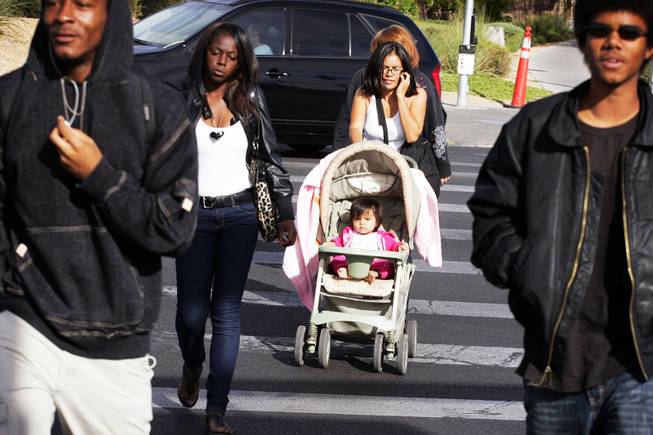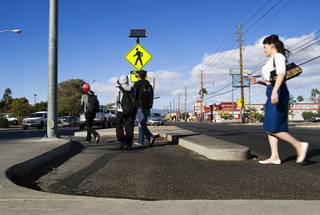
Pedestrians cross the street at the busy intersection of Boulder Highway and Tropicana Avenue in Las Vegas on Thursday, Nov. 3, 2011.
Tuesday, Nov. 8, 2011 | 2:01 a.m.
Interactive map
Pedestrian killed near Alta
KSNV coverage of pedestrian being hit and killed in Las Vegas, Nov. 5, 2011.
Related stories
- A strategy for pedestrian safety in perilous Las Vegas
- Seven ways crosswalks are designed for safety
- 2 pedestrians hit by vehicle on Las Vegas Strip (11-7-2011)
- Despite recent fatalities, number of pedestrian-auto deaths down (11-2-2011)
- Grants to help NLV police target pedestrian safety (10-5-2011)
- Q and A: Pushkin Kachroo, Director of UNLV’s Transportation Research Center (9-3-2010)
- LV Becoming Paradise For Many Jaywalkers (4-15-1979)
- Pedestrian fatalities climbing (5-1-1988)
- LV pedestrian deaths linked to tourists (8-30-1992)
Sun Coverage
A 15-year-old boy hit and killed on a Henderson street, a trick-or-treater dies after being hit by a car in Summerlin, a woman dead after being struck near Nellis Air Force Base and two pedestrians hospitalized after they were hit on the valley's most famous stretch of road — the Las Vegas Strip.
The past 10 days have been a bad time to be a pedestrian in Las Vegas. Four pedestrians died and five more were injured.
It sounds abnormal, but it really isn’t that strange for Las Vegas. One recent study claimed that the city is the sixth-most dangerous place in the nation for pedestrians.
A 1979 Las Vegas Sun article said the city had become an “international paradise for jaywalkers.”
Old-timers may remember a similar run of pedestrian accidents that killed 16 people during the first three months of 1995. That’s one person every 3 1/2 days.
More recently, in the three-year period that ended July 31, there were 84 pedestrian deaths and more than 2,000 injuries from 2,060 crashes in Clark County, according to data from the Nevada Transportation Department.
There have been different approaches to the problem. Pedestrian bridges were added to the Strip. Metro Police have been ticketing jaywalkers as well as motorists who ignore crosswalks — at times using a turkey-suited officer as decoy. Crossing guards now wield stop signs with flashing lights.
The next round of safety enhancements is being researched in a small, windowless laboratory on the third floor of UNLV’s Science and Engineering Building.
Here, in a room equipped with a dozen computers, a large table holds models of intersections, some complete with working stoplights.
Assistant Professor Alexander Paz emerges from his office, where the small whiteboard is covered with the diagram of an intersection. He explains some of the projects his students are working on.
Some are far-flung, like the proposal to lower Maryland Parkway and Harmon Avenue next to the UNLV campus so pedestrian bridges could be built at ground level, where people are more likely to use them.
“It’s expensive, of course, but very efficient,” Paz said.
This semester, a group is studying the prospect of installing infrared devices at crosswalks to detect pedestrians. The devices would then activate traffic signals or warning lights to stop traffic for the pedestrians, eliminating the need to push buttons to activate the lights, which some pedestrians don't do before crossing a street.
The projects aren’t without precedent for effecting change. Before Paz’s time at the university, the county readjusted a crosswalk on Maryland Parkway near campus after a graduate student proposed reshaping the median into an "S-curve" to force pedestrians crossing the street to face oncoming traffic.
But the really exciting stuff, at least to Paz and his associates at the Transportation Research Center, is the creation of a massive database, with input from law enforcement agencies, emergency responders and University Medical Center. The goal is to gather all of the data possible on every accident in the region for the past decade.
After a fatal or serious-injury accident, police investigate and record a massive amount of information about the crash. But that data isn't always integrated with other sources of information, such as victim medical records or the design and operation of the roadway, Paz said.
If researchers can gather all the data possible, they will get a better picture of how to avoid accidents, he said.
But there is still a missing piece to the puzzle, Paz said.
Investigators can only gather evidence after the crash. They weren’t there to record the weather, road conditions and exact circumstances before a collision.
That’s where virtual research comes in. Researchers are using a driving simulator to learn more about how people react to distractions.
The simulator includes a driver’s seat, steering wheel, gas and brake pedals and three monitors to act as windshield and mirrors. It can be used to re-create the weather and driving conditions before an accident.
The machine lets researchers test different scenarios and see what the impact of distractions are, whether it’s flashing lights along the road, a ringing cellphone or the buzz from one-too-many beers.
But that’s not enough. Some graduate students are working on new software to make the visuals more realistic and to give them more flexibility in creating driving scenarios. That step should be done next summer.
Then, the students plan to add pedestrians to the mix. Right now, the software adds pedestrians for the driver to avoid, but the computer-generated people don’t behave the way real people do. They don’t weave through stalled cars, for example.
But by the end of next year, the team hopes to add real pedestrians to the driving simulator, doctoral student Naveen Veeramisti said.
The pedestrians will use goggles to see the simulation, a treadmill to walk on and an Xbox Kinect system to add their movements to the simulation for the driver to see, Veeramisti said.
Once the pedestrians are in the mix, they also hope to add a bicycle simulator, he said. No other university has a simulator that incorporates the three transportation modes.
When they are able to combine the data from real accidents with data collected from the simulator, researchers should be able to answer some of the questions that have plagued traffic engineers, such as when and where a crosswalk should be installed, Paz said.
While safety advocates say crosswalks are always a good thing, some traffic engineers, looking to move ever-increasing numbers of cars, say they are added distractions that give pedestrians a false sense of security.
Erin Breen, the director of UNLV’s Safe Community Partnership, which is also part of the Transportation Research Center, dismisses that argument.
“I think it’s engineering out of a book instead of engineering for human nature,” she said. “What a marked crosswalk gives you is a situation where motorists expect to see someone.”
Paz doesn’t really take a side. He says that’s one of the areas that the accident database and the simulator will help them research.
“There is no consensus on whether or not it is good to have crosswalks,” he said. “Some people like it and other people don’t. Right now, we just aren’t clear about it.”
Paz agrees with Breen that educating drivers and pedestrians is a key to safety, but says when it comes to designing safer roads, data are going to bring the answers.
“We have to know what is reality,” he said. “We cannot just make guesses and then depend on those guesses.”



Join the Discussion:
Check this out for a full explanation of our conversion to the LiveFyre commenting system and instructions on how to sign up for an account.
Full comments policy